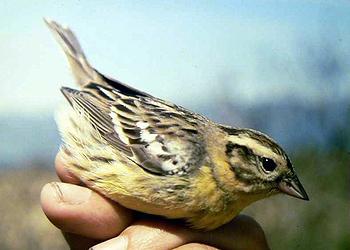
CAMBRIDGE, UK, December 9, 2013 (ENS) – The number of bird species listed as Critically Endangered has soared to an all-time high, reports BirdLife International with the release of this year’s Red List for Birds. Even so, some conservation efforts are succeeding.
Critically Endangered is the highest risk category on the IUCN Red List of Threatened Species maintained by the International Union for the Conservation of Nature. BirdLife is the authority for birds on the IUCN Red List.
“Almost 200 species of bird are now in real danger of being lost forever,” said Dr. Leon Bennun, BirdLife’s director of science, policy and information. “They are being hit on multiple fronts. Habitat loss, agricultural changes, invasive species and climate change are the principle threats. Without these problems being addressed the list will continue to grow.”

The White-winged flufftail, Sarothrura ayresi, a small, elusive, dove-sized rail endemic to Africa, is the latest to join the lengthening list of species on the brink of extinction. This secretive bird clings to survival in the upland marshes of central South Africa and Ethiopia.
Dr. Martin Fowlie of BirdLife International says, “Destruction and degradation of its high altitude wet grassland habitat, including wetland drainage, conversion for agriculture, water abstraction, overgrazing by livestock and cutting of marsh vegetation, have driven it to this precarious state.”
“Urgent action is now needed in both Ethiopia and South Africa to better understand the species’ ecology and to address these threats and save it from extinction,” blogged Dr. Fowlie in late November.
Some South African sites have some legal protection, and at least four sites are protected by the landowners. At the largest Ethiopian breeding population, the vegetation is not cut for fodder until October-November, giving the White-winged flufftails time to breed without disturbance, BirdLife reports.
The Yellow-breasted bunting, Emberiza aureola, is disappearing due to uncontrolled trapping in its wintering grounds in southern China and Southeast Asia. This once common species, classified as of Least Concern as recently as 2000, is now considered Endangered, just one step below a Critically Endangered listing.
Yet the latest bird assessments are not all discouraging. There are signs that conservation action is working.
Two species of albatross, one of the most threatened bird families, are now considered to be at a lower risk of extinction after increases in their populations.

“Black-browed and black-footed albatrosses have both been downlisted to lower Red List categories,” said Andy Symes, BirdLife’s global species officer. “There is still some way to go, but this gives us great hope for turning around the fortunes of other albatrosses.”
“Bycatch in fisheries is the main threat, and efforts are underway in many longline and trawl fleets worldwide to reduce the numbers killed,” said Symes. “If we can keep this up, there is real hope that the black-browed and black-footed albatross will set a trend for the future.”
On the Indian Ocean island of Rodrigues, two species – the Rodrigues Fody, Foudia flavicans, and the Rodrigues Warbler, Acrocephalus rodericanus – have been downlisted as a result of conservation action.
Habitat protection and reforestation, employed to protect the island’s watershed, as well as the absence of catastrophic storms, have helped these species to recover.
“This year’s Red List is a mix of good and bad news, but once again it shows that conservation groups around the globe are succeeding in saving species and preventing extinction – and these committed efforts now need to be greatly scaled up,” urges Dr. Bennun.
More good news emerged from a meeting November 29 in Bonn. The government of Egypt, in cooperation with Germany, Switzerland and other partners, has pledged to assess and further address the issue of unregulated hunting and bird netting practices along the Mediterranean coast of Egypt.

Top-level officials from Egypt made the pledge at a meeting at the UN Campus in Bonn with representatives from the Convention on Migratory Species, NGOs and wildlife experts.
Egyptian Environment Minister Laila Iskandar said, “The Egyptian government is working towards strengthening the enforcement of domestic laws which limit hunting and stipulate specifications for the nets so as to leave openings for bird species to complete their migration cycle. At the same time, Egypt welcomes cooperation with international partners to improve and strengthen enforcement and further assessments.”
The hunting and trapping of migratory birds in Egypt and Libya, through the use of mist nets along vast stretches of the Mediterranean coast, have become issues of growing public concern. Regulatory frameworks are in place, the challenge lies in their enforcement.
“Bird trapping in these countries is an ancient tradition. The main target species, Common Quail, is a local delicacy,” said Marcus Kohler, BirdLife’s senior program manager for Flyways. Other species, such as European turtle-dove and Red-backed shrike, also fly into the nets in large numbers.
“It’s a legitimate way for local people to supplement their diet,” said Kohler. “However, the indiscriminate nature and scale of the trapping has now reached worrying proportions and is having an impact upon other species.”
Current estimates are that millions of birds are caught each autumn as they leave Europe and Asia for their wintering grounds in sub-Saharan Africa.
Copyright Environment News Service (ENS) 2013. All rights reserved.
© 2013, Environment News Service. All rights reserved. Content may be quoted only with proper attribution and a direct link to the original article. Full reproduction is prohibited.
